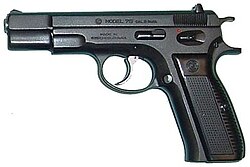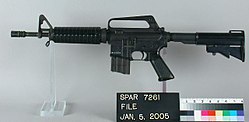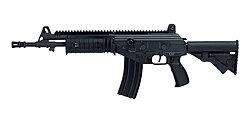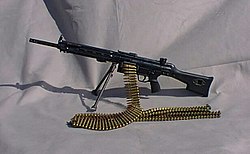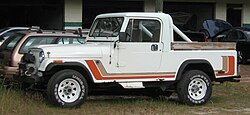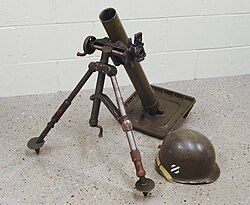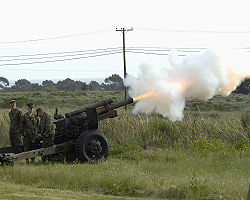Top Qs
Timeline
Chat
Perspective
Salvadoran Army
Land branch of the Armed Forces of El Salvador From Wikipedia, the free encyclopedia
Remove ads
The Salvadoran Army (Spanish: Ejército Salvadoreño) is the land branch and largest of the Armed Forces of El Salvador.
Remove ads
History
Summarize
Perspective
The Football War
The Football War (also called The Soccer War or 100-hours War) was a term coined by Polish reporter Ryszard Kapuściński to describe a brief conflict between El Salvador and neighbouring Honduras. He argued that the war began after the rival nations traded wins during the qualifying round for the 1970 FIFA World Cup. But this event was not the cause of the war. Tensions had been mounting between both nations for several years because of immigration and economic problems, resulting on the war in 1969. The soccer matches incidents just one of several events that happened during that time. Longstanding tensions between the countries were heightened by media reports on both sides, each accusing the other of hooliganism and violence toward their own football fans. On June 26, 1969, El Salvador dissolved all ties with Honduras, the events were used as a call for nationalist pride for both governments and the media.
On July 14 Salvadoran forces began moving rapidly into Honduras following a series of border clashes. Their progress halted after the Organization of American States (OAS) and the United States brought heavy diplomatic pressure to bear on both governments in an effort to effect a cease-fire.
A ceasefire was ultimately negotiated and signed by July 18, with Salvadoran forces withdrawing from Honduras by August 2 following guarantees of safety for Salvadoran citizens in Honduras by the Honduran government.
The Salvadoran Civil War
By the late 1970s, longstanding socio-economic inequality, human rights violations and the unwillingness of the National Conciliation Party dictatorship to address these problems led to the growth of a social movement. The government responded by assassinating thousands of political opponents and massacring students and protestors on several occasions. The heavy handed response of the government signaled to those identifying with the social movement that peaceful solutions were futile, which led to the growth of an insurgency.
On October 15, 1979, the military government was deposed by a joint military-civilian government calling itself the Revolutionary Government Junta of El Salvador (JRG). The JRG's policies were met with opposition from the military and economic elites and government repression increased, with tens of thousands of civilians being killed in 1980 and 1981 alone. This led to the formation of the Farabundo Martí National Liberation Front (FMLN), which brought on a twelve-year civil war. On MArch 24, 1980 Major Roberto D'Aubuisson ordered the killing of Archbishop Óscar Romero; on December 8, 1980 five members of the Salvadoran Army kidnapped and killed missionaries Maryknoll Sisters Maura Clarke and Ita Ford, Ursuline Dorothy Kazel, and lay missionary Jean Donovan under the orders of Carlos Eugenio Vides Casanova and his cousin Col. Óscar Edgardo Casanova Vejar, the local military commander in Zacatecoluca,
The Iraq War

Up to 380 Salvadoran troops of the Cuscatlán Battalion were deployed as part of the Coalition Forces in Iraq between August 2003 and January 2009. They operated alongside the elite Spanish Legion in Najaf. While in Iraq, the Salvadoran contingent suffered 5 dead, and more than 50 wounded.[2][3]
In 2006 the government of El Salvador approached the Israeli ambassador to El Salvador seeking assistance in modernising its army.[4]
Remove ads
Organizational structure


El Salvador is divided into 6 military zones, each of which has its own infantry brigade:
- 1st brigade (San Salvador)
- 2nd brigade (Santa Ana)
- 3rd brigade (San Miguel)
- 4th brigade (Chalatenango)
- 5th brigade (San Vicente)
- 6th brigade (Usulután)
Furthermore, the army has the following units:
- 1 Special Military Security Brigade consisting of 2 Military Police, 1 Foot Guards and 2 border security battalions,
- 8 infantry detachments with 2 battalions,
- 1 Engineer Command with of 2 battalions,
- 1 artillery brigade with of 2 field artillery and 2 anti-aircraft battalions,
- 1 mechanized cavalry regiment with 2 battalions, and the
- Special Forces Command with 1 Special Operations Group, and 1 Anti-Terrorism Command.
- 1 female soldiers battalion on the artillery brigade
Remove ads
Equipment
Summarize
Perspective
This section needs additional citations for verification. (July 2009) |
Infantry weapons
The Salvadoran Army/Navy/Marines/Air Force use the same kind of small arms types. It also uses telescopic sights, Aimpoint T2 Micro, Ohuhu OH-RG-SC Reflex Sights (panoramic sights), EOTech EXPS 3-0 sights, Barska Holographic Reflex Red Dot Sight, Ozark Rihno Tactical Sights, Trijicon MRO-C sights, EOTech 512..A65 sights, Vortex Optics StrikeFire II sights, Burrist Fast BFire3, Tasco Red Dot Sights, CVLIFE Optics Hunting Rifle Scope 2.5x40e red and green illuminated crosshair mount sights in every kind of assault rifle and rifle that all military branches of the Salvadoran armed forces use.
Remove ads
Vehicles
Summarize
Perspective
Note: Sources are circa 1988, while some equipment listed may no longer be in service.
Armored combat vehicles
Logistic vehicles
Artillery
Air-defence equipment
Remove ads
Notes
Bibliography
External links
Wikiwand - on
Seamless Wikipedia browsing. On steroids.
Remove ads






